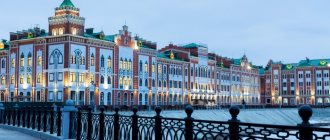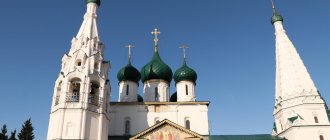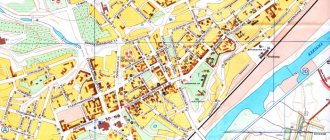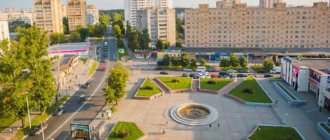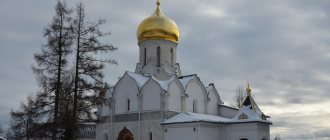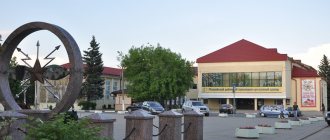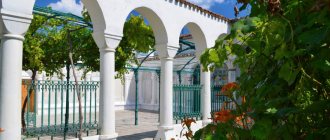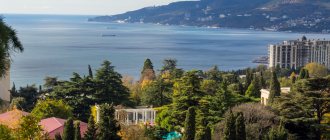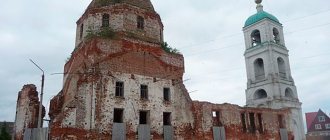Home / Russia / Sights of Kolomna
When planning a weekend getaway, you should pay attention to Kolomna, whose sights can be seen in one day. This ancient Russian city, nestled in the picturesque hills at the confluence of the Moskva River and the Kolomenka River, is filled with fascinating legends about the times of Dmitry Donskoy and the Polish intervention. Here are preserved the remains of a powerful medieval outpost - the Kolomna Kremlin, which was built in the image and likeness of the Moscow one, Orthodox fortress-monasteries and churches with a history of more than half a thousand years. The historical part of Kolomna is home to many museums, many of which are unique.
Kolomna was first mentioned in 1177; for a long time it was part of the Ryazan possessions, and in 1301 it was annexed to the Moscow principality by the youngest son of Alexander Nevsky, Daniil. The wooden fortress, which protected Russian lands from attacks by steppe nomads, was captured and burned to the ground several times. After construction in the middle of the 16th century. brick Kremlin with high battlements and 16 defensive towers with loopholes, no one was able to take it by force of arms.
When the borders of the ancient Russian state expanded and the city lost its border status, crafts began to actively develop, some of them, through the efforts of the townspeople, were restored and are now full-fledged attractions of Kolomna along with architectural masterpieces.
Architectural landmarks
Kolomna, whose attractions stand next to modern buildings, attracts lovers of ancient Russian architecture.
| Architectural objects | Location | Operating hours and additional information |
| Kolomna Kremlin | st. Lazhechnikova, 5 |
|
| Pyatnitsky Gate | St. Zaitseva, 4 |
|
| Ozerov's House | St. Krasnogvardeyskaya, 2 |
|
| Estate of the Lazhechnikov merchants | St. October Revolution, 192a |
|
Kolomna Kremlin
The cultural and historical complex was erected in the 15th century. and served as protection against Tatar raids. On an area of 24 hectares there are also several churches and 2 convents.
The Kolomna Kremlin had 16 towers and several gates. The length of the walls reached almost 2 km. But the architectural object has not been completely preserved to this day. During many battles and human activities, some parts of it were destroyed.
Pyatnitsky Gate
Pyatnitsky Gate was the main entrance to the Kolomna Kremlin. The building, whose height is 29 m, has a horseshoe-shaped entrance. It was from the Pyatnitsky Gate that the construction of the Kolomna Kremlin began. Icons are placed on the two-tier tower, the length of which is 23 m and the width of 13 m. They depict the defenders and patrons of the city. The words of the prayer are also written here.
Ozerov's House
Ozerov's house was built in the 18th century. It was the property of the local merchant Ozerov. The 2-story building is equipped with a pediment. The building has 2 entrances: the front entrance and the regular one on the other side.
Today it is a cultural center that houses a museum and hosts various exhibitions. Concerts and master classes for children and adults are organized here.
Estate of the Lazhechnikov merchants
In an 18th century mansion. lived the writer Lazhechnikov, who is the founder of the Russian historical novel. The rich house has its own small park and is fenced with gates. In the estate you can see household items and clothing from the 18th and 19th centuries. Various theme nights are held here, and silent films are shown here.
How to get to Kolomna from Moscow
- By train Moscow-Ryazan: Departure there: 07:12, 08:30
- Return departure: 19:41
- Travel time: 1 hour 40 minutes
- Ticket price: from 435 rub. one way
- Departure there: 8:30, 8:48
- Departure there: 8:30, 9:10
- 94 km along Novoryazanskoye Highway or 110 km along M-4 (toll section) and the Central Ring Road, ~1.5-2 hours
What is the best way to go to Kolomna?
A train or electric train is, in my opinion, the most convenient way to get to Kolomna. No traffic jams and quite fast. There are two things to consider when purchasing tickets:
- It is better to buy tickets for the Moscow-Ryazan fast train in advance. Especially in the summer season. There may no longer be seats available before departure.
- There are two railway stations in Kolomna: platform Kolomna and Golutvin. Golutvin is the main station, all express trains stop there, and it is the final station for some suburban trains. But it is located further from the historical center of the city (~5 km). The Kolomna platform is near the historical center (~3 km), but not all trains and express trains stop there. From both stations you can reach the center by tram.
by car if you live near the Novoryazanskoe highway or the M-4. Otherwise, the one-way journey can take up to 3 hours: the Moscow Ring Road in the south is often at a standstill, and there are always traffic jams on the Novoryazanskoye Highway in the Lyubertsy area. If you drive along the less busy M-4 and Central Ring Road, the total mileage will be a little more, and you will have to pay for toll roads.
Religious sites
Kolomna, whose religious sights show the features of buildings in various faiths, occupies an area of 65 square meters. km. In the city, a large number of churches are Orthodox. There is also a mosque and an Old Believer church.
| Religious sites | Location | Operating hours and additional information |
| Staro-Golutvin Monastery | St. Golutvinskaya, 11 |
|
| Bobrenev Monastery | S. Staroe Bobrenevo |
|
| Holy Trinity Novo-Golutvin Monastery | St. Lazareva, 11 |
|
| Church of St. Nicholas on Posad | St. Posadskaya, 18 |
|
Staro-Golutvin Monastery
The monastery is located in a picturesque location near the Moscow and Oka rivers. On the territory of the monastery there are utility buildings, 2 dormitories for monks and 2 temples.
There is a monument to Sergius of Radonezh, under whose leadership the monastery was built. There is a theological seminary on the territory and there is a burial place of Grigory Golutvinsky, who was the first rector of the temple.
Bobrenev Monastery
Another monastery located near the city. Construction began in the 14th century. The monastery was erected by Dmitry Donskoy after a crushing victory over the troops of Mamai in the Battle of Kulikovo.
The Mother of God Nativity Monastery is made in blue and white colors and consists of 2 churches, rooms for monks and outbuildings. It houses the Feodorovskaya Icon of the Mother of God.
Holy Trinity Novo-Golutvin Monastery
Convent of the 19th century. consists of 2 churches, a bell tower and a chapel, a refectory and a monastery for nuns. There is a small hotel for pilgrims.
In the monastery you can see dogs and a camel. There is a medical center on the territory of the Holy Trinity Novo-Golutvin Monastery. Here you can purchase icons and items made by nuns.
Church of St. Nicholas on Posad
The Church of St. Nicholas on Posad or the Church of the Resurrection of Christ belongs to the Old Believer church. Snow-white building from the 18th century. has a unique roof. It is decorated with 106 kokoshniks arranged in 5 rows. There are 5 domes at the top. You can enter the temple only during services.
During other hours the church is closed to visitors.
Temples and monasteries of Kolomna
Epiphany Staro-Golutvin Monastery
On the outskirts of the city there is a monastery, which was founded in the 14th century. According to historians, the abbot of the monastery was initially a student of Sergius of Radonezh himself. Fragments of the original foundation of the monastery can now be seen in the foundation of the Epiphany Church. It was built in the 18th century and is currently the oldest building of the monastery.
Bobrenev Monastery
This monastery is popular among pilgrims who come to see the icon of the Theodore Mother of God
. She is considered miraculous and has a reputation that she can help resolve family issues and is also capable of healing. The monastery was built in 1381, a year after the Battle of Kulikovo Field. Such a significant age of the monastery allows us to call it the oldest in Kolomna. It is located where the Vladimirsky tract previously passed
Church of the Conception of John the Baptist in Gorodishchi
There are only two surviving churches built in the 14th century in the Moscow region. This is one of them. It passed through the centuries unchanged, unlike many similar structures that were demolished over time in order to build new, stronger and more spacious ones in their place. This temple even preserved Batu’s seal, which is an image of a certain mythical animal. The seal can be seen on the northern wall of the temple.
Church of St. Nicholas on Posad
The location of this church is Posadskaya Street. Actually, that’s why part of its name sounds like that – “on Posad”. This temple was built at the beginning of the 18th century. The style of construction is Moscow patterned. The church has a very interesting architecture, which makes it stand out from other buildings. The upper part of the temple is formed by 105 kokoshniks, which are topped with five domes. Some of the decorative elements were restored by restorers during the Soviet Union. At the moment, the temple is run by Old Believers.
Church of the Exaltation of the Cross
Right behind the Pyatnitsky Gate of the Kolomna Kremlin is the Church of the Exaltation of the Holy Cross. It was built in the 30s of the 19th century. The temple architects chose classicism as the main style. The church is crowned by a large domed rotunda. The temple building is connected to the nearby bell tower by a high passage.
Temple of the Tikhvin Icon
In 1776, a temple appeared in the city, the creation of which was contributed by the local merchant Ivan Meshchaninov. This religious building was built on the Cathedral Square of the Kremlin, and it was named in honor of the Tikhvin Icon of the Mother of God. Almost 100 years later, another Kolomna merchant, Tupitsyn, took care of the church. His funds helped expand the temple. Since 1861, the temple became five-domed. With the advent of Soviet power, the decoration of the church was seriously damaged, and its heads were demolished. Much later, already in the 90s of the last century, the temple was restored, including its internal paintings. Adjacent to the temple building is a bell tower, on which you can see a massive two-ton bell.
Church of St. John the Evangelist
Once upon a time, the church of the same name stood at the very gates of the Kolomna Kremlin. It was built of wood and therefore simply burned down during the fire. At the same time, it was decided to restore the temple, but from stone and in a different place. Now this place is the Square of Two Revolutions. Construction of the stone church was completed in 1756. However, only more than 70 years later the work on painting the walls and rebuilding the building came to an end. The temple has a 67-meter bell tower.
Brusensky Monastery
In 1552, a monastery was founded in Kolomna. Until the mid-17th century, all buildings on its territory were made of wood. Nowadays the monastery is for women. It has the status of a cultural heritage monument, and at the same time is considered an active religious center.
Museums
Kolomna, whose sights tell about the stages of the city’s formation, has several museums with interesting collections.
| Cultural sites | Location | Opening hours and ticket prices |
| Museum "Kolomenskaya pastila" | St. Posadskaya, 13a |
|
| Museum of Flax and Life of Russian Women | St. Civil, 80 |
|
| Museum-Estate “House of the Samovar” | St. Posadskaya, 11 |
|
| Kolomna Local Lore Museum | St. Lazhechnikova, 15 |
|
Museum "Kolomenskaya pastila"
The Kolomenskaya Pastila Museum has been operating since 2009 and is located in a small building where the Suranovs’ confectionery used to operate. Visitors can see with their own eyes how the famous Kolomenskaya pastila is prepared and taste it. The cooking process takes place like the 19th century. on old equipment.
Today, museum workers offer about 30 types of marshmallows with various additives. The museum has developed many interactive programs in which visitors can actively participate. There is a cafe and souvenir shop on site.
Museum of Flax and Life of Russian Women
In the museum, where a private collection is exhibited, visitors can get acquainted with 3 types of collections. The first hall shows the life and everyday life of people of the 19th and 20th centuries. Here you can see utensils and household items of that time. The 2nd room tells about the process of turning flax into fabric and its history. The 3rd hall is dedicated to national costumes, towels and looms.
Master classes on making various amulets and linen products, as well as dolls, are held for visitors. After the tour, guests can taste aromatic tea with local marshmallows.
Museum-Estate “House of the Samovar”
Another museum telling about the culture and history of the Russian people. In the “Samovar House” you can see a private collection of samovars, visit a traditional Russian hut and taste delicious tea.
The tours are conducted by the owners of the collection. All objects in the museum can be touched and examined closer. In total, about 150 samovars are presented: from the smallest to the largest. There is also a small cafe serving traditional Russian cuisine.
Kolomna Local Lore Museum
The local history museum in Kolomna offers a closer look at the history of the city in different periods of its formation. The collection numbers about 30 thousand items. On the 1st floor the collection “Nature of Kolomna and Man” is exhibited. The 2nd floor is dedicated to the stages of the city's development.
Kuznechnaya Sloboda
A small museum with one hall with an interesting exhibition - forged products of different sizes and purposes, the work of many master blacksmiths of more than one generation. The guide's informative story will reveal the essence of each item: armor and weapons, scales, irons, and other ancient everyday items.
Sculptures and monuments
Kolomna, whose sights are of historical significance, was founded back in 1177. The city hosted many memorable events and was home to a large number of prominent personalities. Therefore, you can see many monuments and sculptures on the streets.
Monument to Dmitry Donskoy
The sculpture to Dmitry Donskoy was unveiled in 2007 at the walls of the Kolomna Kremlin not far from the Trinity Novo-Golutvin Monastery. The prince sits confidently on his horse and prepares for battle. The cultural composition is located on a large pedestal and rises 12 m in height.
It was in Kolomna that Dmitry Donskoy gathered troops and defeated the Tatars on the Kulikovo field.
Monument to Vodovoz
Another interesting object is the monument to Vodovoz. The profession of water carrier was popular until water supply appeared in cities. Before this, water carriers took water from the river and sold it to local residents in buckets.
The composition depicts a man next to him is a dog and a barrel on wheels for collecting water. The man holds a ladle in his hands. The monument is installed at the end of the street. Vodovoznaya near the Moscow River.
Monument to Sergius of Radonezh
Sergius of Radonezh is a memorable figure for Kolomna.
It was under him that the construction of the Staro-Golutvin Monastery began, on the territory of which the sculpture is located. Saint Sergius made an invaluable contribution to the development of the Orthodox faith in Kolomna.
Monument to Cyril and Methodius
The monument to Cyril and Methodius was inaugurated in 2007 on Cathedral Square near the Oka River embankment during the celebration of the emergence of Slavic writing. The 7.5-meter sculpture depicts Saints Cyril and Methodius holding a Bible and paper with the Russian alphabet in their hands. An Orthodox cross rises between them.
History of Kolomna
Located halfway between Moscow and Ryazan, Kolomna is a very convenient starting point for traveling along the Oka River. First mentioned in the chronicle in 1177 as a Ryazan city, it remained in the ranks of the Ryazan principality until 1301. Murom also belonged to Ryazan at that time. From this point of view, it is logical to travel along the Oka from Kolomna to Murom, preserving a certain historical and geographical integrity. We will not go further along the Oka, but will stop at Kolomna, since we visited Murom last year, when we made a road trip from the Oka to the Volga.
It is true that Kolomna was not founded by the Ryazan people, especially in such a vulnerable place, that is, on the opposite (from Ryazan) bank of the Oka. In much more distant times there was a Vyatic settlement here, the inhabitants of which founded Kolomna. So the city is actually more than eight hundred years old.
After the loss of Kolomna, when the feudal borders sank into eternity, the northwestern border of the Ryazan land remained near this city. It is believed that Kolomna is a kind of “water gate” to the Ryazan region. At the same time, being a Moscow city (“Kolomna town is a corner of Moscow”), Kolomna, with its architecture, rather belongs to the Ryazan-Murom Pooch.
In 1301, the city was captured by the Moscow prince and Kolomna became one of the first lands annexed to Moscow. By the middle of the 14th century, the city grew richer, became a significant trading center, and in 1385 Kolomna was forcibly reclaimed by the Ryazan prince Oleg. However, a few years later, through the mediation of Sergius of Radonezh, the city was again returned to Moscow.
As an important strategic point, Kolomna at the beginning of the 16th century was included in the defensive system of the southern borders of the Moscow state. This entailed the construction of a powerful stone Kremlin, which was not inferior to the Moscow Kremlin in its defensive qualities. In the 17th century, with the transfer of state borders to the south, Kolomna lost its military-strategic significance and gradually turned into a rich trading city. In 1708, Kolomna was assigned to the Moscow province, and in 1781 it received its own coat of arms, which is still its historical symbol.
Parks and squares
A large number of parks and squares have been created in Kolomna, where citizens and guests can enjoy the beauty of the city and relax. Among them there are quite old parks with their own history. Many new parks are also appearing.
Memorial Park
The memorial park was created on the site where back in the 20th century. there was a cemetery. It is located on the street. October revolution. The Museum of Military Glory is open on its territory. The Eternal Flame burns in the park. Here you can see the Alley of Heroes of the Soviet Union, who were from Kolomna.
Memorial Park is a landmark of Kolomna in which the eternal flame burns
The Memorial Park has several sculptures and monuments dedicated to the victims of the Second World War and repression.
Peace Park
The largest park in the city is Peace Park. It occupies an area of almost 30 hectares. In warm weather, there are attractions and events held here. The park has the largest fountain in the city. The height of its jet reaches almost 20 m.
The third day we walk around Kolomna
On the last day, you can continue to explore the sights of Kolomna with your children, walk along museums and embankments. You can dilute the program by visiting entertainment centers.
Museum of your favorite toy
This place in Kolomna will be more to the taste of parents, because they will have an excellent opportunity to show their children their favorite things from their childhood. This is a small private museum filled with toys. You can pick up all the exhibits, take pictures with them, play with them, remembering the past.
The excursions are conducted by the owner herself, and there is also a person working here who conducts master classes on making toys - both children and adults can learn. There is a large selection of dolls: from those made in Tsarist times to modern, trendy Barbies. The museum has a separate play area for children.
Museum "Kalachnaya" in Kolomna
Visit the museum-bakery, which produces the famous Kolomna rolls right in front of guests. There is no usual exhibition: here they show the process of creating the city's ancient baked goods. And they start by mixing several types of flour. During the excursion, guests learn how to cook rolls.
The second stage of the museum’s program is a master class on the proper use of hot pastries, served with butter and a glass of tea. While tourists try the treat, the hospitable baker tells the story of the kalach and reveals its secrets. He will also tell you how Kolomna pastries were sold in France. Separate master classes are held for children. You can buy fresh produce in the shop at the museum.
Museum-manufactory “Fragrant Joys”
Another piece of pre-revolutionary Kolomna on the streets of the modern city is intended for visiting by the whole family. You can find a shop-museum near the Pyatnitsky Gate. This is an ancient building that once belonged to the local merchant and soap maker Suranov.
The owners of the miniature museum recreated the atmosphere of a pre-revolutionary merchant shop that offered fragrant goods to residents and guests of Kolomna. During the tour, guests are shown and allowed to smell samples of soap prepared according to ancient recipes. They tell in detail how this fragrant miracle was made and how it was used. Here in the museum, children will learn about ancient perfume.
In the museum shop you can buy soap, brewed and packaged according to pre-revolutionary traditions. Other perfume products from a long time ago are also sold here.
Kuznechnaya Sloboda in Kolomna
A small free museum in Kolomna dedicated to the blacksmithing industry that flourished in Kolomna before the revolution. The collection consists of 7,000 antique objects: iron, wood, wicker, but related to the forge. Show the children what kind of armor the warriors wore, how they forged tools for the peasants, and what convenient things the blacksmiths made for the residents of Kolomna.
There are also children's things on display in the museum: forged sleds, pots, toys. Nearby you will find adult bast shoes, cast iron irons for housewives, and ancient harnesses. The museum offers excursions and has a souvenir shop.
House of Labyrinths in Kolomna
Children can take a break from visiting museums in the House of Labyrinths. The bright world of ribbons and mirrors will captivate children and adults for a long time. The main thing is to remember to prepare your camera for “Alice Through the Looking Glass” style shots. To create an intricate space, one hundred kilometers of multi-colored ribbons, many mirrors and lamps were used.
This is not just a walk through an intricate labyrinth: guests need to complete a series of tasks in order to leave the hospitable place. And the whole family will have to find a mysterious hexagonal room hidden inside the House of Labyrinths.
Gorki Zoo
If you have some free time left, you can visit the Gorki area and take your children to the Kolomna petting zoo. Tame llamas, deer and donkeys live in a small area. There are many animals that came from different continents. There is an enclosure with ostriches and a pen with bison.
There is a riding school at the zoo. In addition to rides on traditional ponies and horses, children are offered to ride donkeys and camels. Parents purchase farm dairy products at the store. The whole family can have a snack at a local cafe, and then take a pleasure boat ride along one of the Kolomna rivers.
Interesting and unusual places
Kolomna, whose sights are difficult to see in 1 day, has many interesting places outside the city:
- St. John the Theologian Church (Two Revolutions Square, 1). A beautiful temple in the classicist style with a bell tower, the height of which is about 67 m. In the temple you can see an ancient bas-relief icon of the 16th century. made of stone.
- Museum of the Origin “This money is Kolomsk” (Zaitseva St., 14). The Museum of Origins is located in the Pyatnitskaya Tower in the basement. In one hall, visitors can observe icons and objects from the everyday life of the Russian people. The second room displays jewelry and a collection of coins from various periods.
- Museum of the History of Housing and Communal Services (Lazareva St., 2a). The Museum of the History of Housing and Communal Services is located in a building that was previously used to store water. There are free excursions here that tell about the stages of the formation of public utilities in Kolomna.
- Tram Museum (Dmitry Donskoy St., 15). The first tram in Russia was produced in Kolomna. The museum's collection includes more than 150 scaled-down replicas of trams from all over the world.
- Kolomna Theological Seminary (Golutvinskaya St., 1). Priests and church ministers are trained in this educational institution. It has its own temple.
Where to go with a child in Kolomna
Tourists with children in Kolomna are offered a large number of thematic excursions in which children will not get bored. There are also many other establishments where children and their parents can have a great time.
- A complex of giant wooden slides and swings. This complex was built for the European Speed Skating Championships. In winter, Maslenitsa celebrations are organized here. Children will be happy to run around on the numerous large slides.
- Boat trips (Registration at Vodovozny lane, 12). A fascinating journey along the river allows you to enjoy the beauty of the surroundings and see the drawbridges.
- Trampoline (Oktyabrskaya St., 88a). You can have a great time at the trampoline center. Here visitors have the opportunity to jump on their own or under the supervision of a professional.
What to see in Kolomna in 1 day by car
Kolomna is rich in attractions. Here everyone can find interesting objects. The city organizes many excursions that cover famous and memorable places in Kolomna.
If tourists have allocated only 1 day to explore the city, it is best to use it for the following route:
- Kolomna Kremlin;
- Kolomna Local Lore Museum;
- Estate of the Lazhechnikov merchants;
- Memorial Park;
- Museum of Military Glory;
- Spasskaya Tower;
- Pyatnitsky Gate;
- Old Golutvinsky Monastery.
Museum "Kolomenskaya pastila"
Pastila is a symbol of the city, so it is not surprising that the pastila museum is located in the center of Kolomna in one of the buildings of the estate of the Suranov merchants. In the atmosphere of past centuries, while drinking tea with the most delicate marshmallows, it is pleasant to listen to the history of the city and its inhabitants who glorified it. The excursion is shown as a theatrical performance. Actors dressed in historical costumes show visitors scenes of tea drinking accompanied by a story about the past life of the residents of Kolomna.
What to see in Kolomna in 2-3 days
There are many temples and monasteries in Kolomna. Therefore, it is worth setting aside a separate day to visit these spiritual places.
Day 1:
- Kolomna Theological Seminary;
- Old Golutvinsky Monastery;
- Trinity Church;
- St. John the Theologian Church;
- Bobrenev Monastery;
- Church of St. Nicholas on Posad.
Day 2 can be devoted to visiting the local Kremlin and Cathedral Square:
- Kolomna Kremlin;
- Assumption Cathedral;
- Tikhvin Church;
- Church of the Resurrection of the Word;
- Tent belfry;
- Pyatnitsky Gate;
- monument to Cyril and Methodius.
Day 3 should be left for visiting interesting museums and other noteworthy places in Kolomna:
- Museum of Flax and Life;
- Museum "Kolomenskaya pastila";
- Tram Museum;
- Kolomna Local Lore Museum;
- Samovar House;
- A trip along the river by boat;
- Inspection of drawbridges;
- Ozerov's House;
- Estate of the Lazhechnikov merchants.
Museum "Kalachnaya" in Kolomna
The Kolomensky Kalach Museum is worthy of attention for visitors to the city. Here they talk about the traditions of baking kalachi, but the technology is kept secret. You can try the baked goods and buy them right away. City dwellers are interested in looking at the old oven for baking kalachi and at the cooking process itself.
What to bring from Kolomna
Kolomna is one of the most beautiful ancient cities in Russia. After visiting her, I want to leave a reminder of the trip. Many attractions host workshops where anyone can make their own souvenir.
Tourists visiting Kolomna can choose the following as souvenirs:
- The famous Kolomna marshmallow, which is produced in different flavors at the marshmallow museum or at a local factory.
- Kolomna kalachi or pretzels are very popular when visiting the Kalach Museum.
- Many souvenir shops and shops display a variety of works made by local artists and craftsmen.
- Blacksmithing is well developed in Kolomna, so tourists will be able to purchase ready-made forged products or make them themselves during thematic excursions.
- Honey and beekeeping products, as well as drinks based on honey from the Zolotoy Uley brand from the local plant will be a wonderful gift.
- While visiting monasteries or temples, anyone can purchase icons or other objects, many of which were made by monks or nuns.
Kolomna today is a city with developed industry and science, in which there are many churches and monasteries. Some areas and attractions help you immerse yourself in the ancient city.
Article design: Mila Friedan
Lazhechnikov Estate
Here in the 18th century lived the famous merchant-writer, founder of the Russian historical novel genre, author of the work “The Ice House”. The ancient manor is fenced with a gate and there is a small park inside. Today it is a cultural and museum center where the legacy of I. Lazhechnikov is kept.
In the house you will see recreated interiors of old Kolomna - colorful peasant huts, luxurious merchant halls, as well as costumes, furniture and household items from the 18th-19th centuries. Themed evenings, events, silent film screenings based on the writer’s novel, and theatrical tea parties with the famous Kolomna marshmallow are regularly organized for guests.

